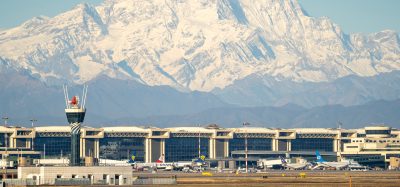ACI Europe passenger data for March 2020 shows impact of COVID-19
- Like
- Digg
- Del
- Tumblr
- VKontakte
- Buffer
- Love This
- Odnoklassniki
- Meneame
- Blogger
- Amazon
- Yahoo Mail
- Gmail
- AOL
- Newsvine
- HackerNews
- Evernote
- MySpace
- Mail.ru
- Viadeo
- Line
- Comments
- Yummly
- SMS
- Viber
- Telegram
- Subscribe
- Skype
- Facebook Messenger
- Kakao
- LiveJournal
- Yammer
- Edgar
- Fintel
- Mix
- Instapaper
- Copy Link
Posted: 9 April 2020 | International Airport Review | No comments yet
As the COVID-19 pandemic continues to impact the aviation industry, data from ACI Europe shows a 59.5 per cent fall in passenger traffic in March 2020.


New data published by Airports Council International Europe (ACI Europe) has revealed that passenger traffic fell by 59.5 per cent during March 2020, causing an overall decrease of 21 per cent for Q1 passenger traffic.
As the COVID-19 pandemic continues, Europe’s economies have come to a stand-still over the past weeks, as has the European airport network. Restrictions to travel and lockdowns imposed by governments, as well as airlines grounding the majority of their fleets, have resulted in passenger traffic at Europe’s airports declining rapidly.
While Europe’s airports handled 5,120,000 passengers on 1 March 2020 (an 11.7 per cent decreased compared to the same day in 2019), that number reduced to 174,000 by 31 March 2020 (a decrease of 97.1 per cent compared to the same day in 2019).
Director General of ACI Europe, Olivier Jankovec, said: “This is like nothing we have seen before. In the global financial crisis, it took Europe’s airports 12 months in 2009 to lose 100 million passengers. With COVID-19, it took just 31 days – the month of March – for that same passenger volume and more to vanish.”
Jankovec continued: “With repatriation flights bringing Europeans back to their home countries coming to an end, what now remains is essentially limited to cargo traffic, as well as sanitary and other emergency air services. While 93 airports have closed their doors – mostly secondary and smaller regional airports – more than 80 per cent of Europe’s airports remain open to commercial air traffic.”
In order to limit the impact of COVID-19, airports are making painful cost-cutting measures wherever it is possible to do so. Despite all efforts to scale down facilities to the bare minimum by shutting down terminals, piers and spare runways, many of the airport costs are incompressible – and debt contracted to finance long-term investments still needs to be repaid.
ACI Europe has further revised its projections in regard to the impact of the COVID-19 pandemic on the regions’ airport operators. The projections reflect actual data for March 2020, as well as taking into consideration the advice from the European Commission (EC) to the European Union (EU) to prolong the current restrictions upon non-essential travel until 15 May 2020. These projections now show:
- A loss of 873 million passengers for Europe’s airports in 2020, representing a decrease of 35 per cent in a year that was predicted to see a 2.3 per cent passenger growth increase in a business-as-usual scenario
- In financial terms, a loss of €23 billion in revenues, representing a decrease of 41 per cent compared to the business-as-usual scenario.
Commenting on the financial challenge, Jankovec said: “For now, what airports are getting to help them get through is essentially temporary unemployment schemes – although not from all countries. This is of course much welcomed, as these schemes help airports reduce costs while retaining their workforce. But airports will need them to be prolonged for as long as necessary – and they also need urgent flexibility on a range of EU regulatory measures that can help them further reduce their costs.”
In addition, ACI Europe also renewed its call for a fully coordinated European Aviation Relief Plan that looks at supporting all actors in the air transport ecosystem, with no supportive measures benefitting one sector at the expense of another.
The trade association also insisted on the need for support to address both current business continuity risks for airports and their business partners, such as ground handlers, caterers and travel retailers, as well as to safeguard their capabilities to restart operations and carry on strategic long-term investments – including for decarbonisation.
Jankovec added: “Airports are local jobs machines. They very often are the largest employment site in their communities, regions or even at national level. That reflects the value and role air connectivity plays for economic growth – with every 10 per cent increase in direct connectivity yielding a 0.5 per cent increase in GDP. This means restoring air connectivity must be at the forefront of the EU’s exit and recovery strategy. Such a strategy will need to guarantee an orderly transition from today’s patchwork of restrictions to travel – and be based on effective coordination both within the EU and internationally.”
In order to support the EU and governments in that exercise, ACI Europe is mobilising its resources and working closely with its 500-strong airport membership. The trade association is launching a dedicated ‘OFF THE GROUND’ project, which will map the breadth of the issues that airports and their business partners face in restarting full operations and restoring air connectivity. The objective is to identify best practices, provide airports with a common set of guidelines and governments and policy makers with advice and essential requirements.
Related topics
Aeronautical revenue, Airport crisis management, COVID-19, Economy, Non-aeronautical revenue, Passenger volumes


















